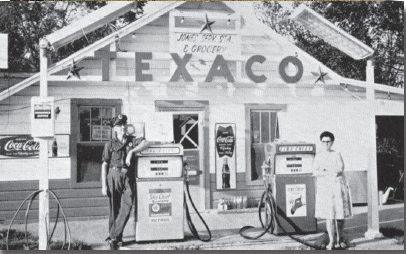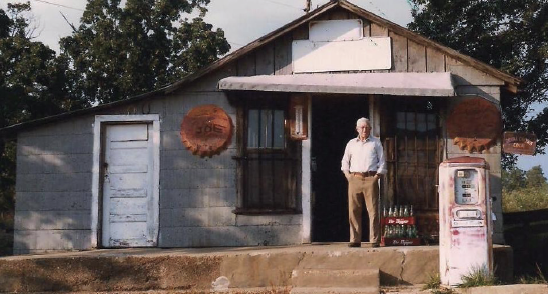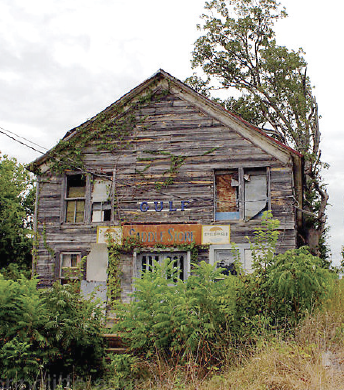THE RISE AND FALL OF COUNTRY STORES
Tammy Curtis, Managing Editor-This is a reprint from an March 20, 2021 article published by the Spring River Chronicle that has been requested to be digitized by a group after work has began on the Saddle Store. We will be doing a follow up story when information becomes available.
They dotted the American landscape and for many in rural America, great childhood memories were realized within the doors of these small country stores.
Several were housed in Sharp and Fulton Counties that have long since been replaced by the big box and chain grocery stores. Country stores were not only a way of life for those living during the time, but also a means of survival during hard times and a social gathering place.
From the thousands of silver and colored circles implanted deep as if to pave the driveway from long since abandoned soda lids to the aging soda and petroleum signs that greet visitors, country stores were a staple during the 40’s to late 80’s. The pleasant smell of molasses in livestock feed and grain to the colorful arrays of candy sticks and gum balls on the tall wood counter tops were common to most. Also, the rolled glass candy displays and simple wooden shelving were staples in the wooden floored buildings that served families across rural Arkansas.
JONES STORE

The Jones store, featured in one of the photographs is now a simple turn around location in the “blink and you missed it” Fulton County town of Agnos. The store sat directly across from the post office, where postmasters Buford and later, Freda Estes sorted the mail each day for delivery. The post office too is long gone.
The clink of the bottles being removed from the soda boxes and ice cold chill of the drinks offered more than their share of relief during the hot summers of putting up hay. There was nothing like the thick bologna sandwiches on the freshest bread that ever stuck to the roof of your mouth were made by the store owners.
Children and adults alike would spend family time taking walks down the dusty country roads picking up the glass soda bottles which were so thick they rarely were broken when haphazardly thrown from passing vehicles. The return of the bottles was often very profitable, as the manufacturers re-bottled the drinks. It was great fun for youngsters to challenge their siblings to see who could find the most. The refunds most always guaranteed a candy bar or bottle of ice cold pop in return.
Before the R.C. Jones family owned the store at Agnos, the Looney family were the proprietors. The R.C. Jones family owned the store in its prime in the 1960s and years later, Mr. Jones’ family ran a small store at Glencoe, just a few miles up the road. During the 60’s and 70s in the area, the closest large store was either in Mountain Home, which required a ferry ride across Lake Norfork, often with long waits, or over an hour drive to Batesville. It is easy to see the indispensable role these stores played in the lives of rural Arkansans. They also also offered a small credit line to locals for food or livestock staples until their paychecks arrived. This was all done on little more than a handshake and good faith, something that would never work in the current day.
ELLIS STORE

Although Jones store was popular in Agnos, just up the road was the Hubert Ellis Store, just off Peace Valley Road, both had colorful candy counters, serve yourself “soda pop” and even an old fashioned scale and cash register.
The “ca ching” of each item being manually entered with the round wooden keys is something modern days beeping scanners will never equate. The anticipation as the drawer flung out as a child was so exciting.
Newborn babies were weighed first on the white enamel produce scale and as they grew too large to fit, were thrilled as Mr. Ellis placed them on the feed scale, instructing them, each time to be very still. Children would stand in anticipation as he added first one weight, then another with a slight tap right, then left before announcing the final weight determination.
This was often followed by providing children with a ceremonial stick of candy for being still. Mr. Ellis kept a record of all the local children’s weights and heights so as to tell them each time how much they had grown.
Adults had their share of fun too, the men would always have a friendly game of checkers going, and loved to claim bragging rights. Women often brought fresh eggs from their chickens for Mr. Ellis to sell.
One thing was for certain, there was always a bag of peanuts to shell and bright brass spittoon in front of the wood stove. If anyone needed to know who was expecting, had a baby, died, was down on their luck and needed a little help, or who was getting married or even divorced,, the country stores provided the social platform as well,
Many families bought all of their “bill of groceries” with Ellis’ assistance. The old stores also had gas pumps and lots of fellowship from friends and neighbors. Most all were suited with a black pot bellied stove, around which many a tall tale was told. Ellis made a weekly trip to Thayer, Mo. to purchase provisions for the store from Wallace and Owens. From horse feed to fresh meat, produce and other staples, Mr. Jones and Ellis made sure the communities in Agnos and surrounding areas had all they needed. Mr. Ellis worked up until his death in Oct. 1988 and was a lifelong friend to many in the area.
Similar stores in Saddle, Violet Hill, Ash Flat and Evening Shade’s customers from days gone by all undoubtedly held similar personal memories of their visits, something large retail grocery stores can never replace. These were not only stores, they were a part of area resident’s local heritage, many tell our children, and grandchildren even today.
SADDLE STORE

Another country store is still standing, yet falling daily into deeper state of disrepair. The former Saddle Store located on Highway 289 was one of the only local country stores that was added to the National Register of Historic Places in 1998.
Plans had been discussed over the years to remodel and preserve the largest of the area stores, but to date nothing has been done and it continues to fall.
The two story landmark has perhaps the most historical research on its creation and operation.
On one historic website, the late Zara Sutherland Jones, who lived in the area in the 1920s recalled the area during that time frame in a story in 1999 that ran in the Jonesboro Sun.
The features of Saddle were its grist and flour mills and cotton gin, said lifelong Saddle resident Doug Jones, who added that the dam was built in 1870 with rocks from a nearby bluff.
The town of Saddle was referred to as Sharp’s Mill, after its founder, Ephraim Sharp. The town was later called South Fork because that was the name the local post office adopted.
Although it is believed that the building was constructed in 1916, Mrs. Jones, who moved to the area in 1921, claimed in the article, the Saddle Store was built in 1927.
The Arkansas Historic Preservation Program (AHPP) indicated that “either Joe Hatman or a Mr. (Jim) Benton constructed the store.”
Jones insisted that Saddle merchant Hatman built the store and recalled he operated a creamery under the store.
Mrs. Jones said Hatman, who had moved to Saddle from Hardy, operated Molly Nickels’ general store, which was located closer to the dam, before having the existing Saddle Store built. Mrs. Jones indicated that Mrs. Nickels became ill, moved to town and sold her store to Mrs. Jones’ father, De Witt “D.W.” Sutherland.
Jones also recalled how the new name of the town of Saddle came about. She said Bill Riley had a shop behind the Saddle Store where he shod horses and that Earl Sterling was in charge of the post office.
In the interview with Mrs. Jones she explained . “At about the time the men were deciding on a name for the town while standing on the porch of the Saddle Store,” she said Hershel Rogers brought his son’s saddle around the side of the building. Upon noticing the saddle, one of the men recommended calling the town Saddle, and it stuck.”
The South Fork Post Office was discontinued on May 29, 1925, and the Saddle Post Office was built March 20, 1928, said Jones.
Mrs. Jones also recalled attending school across the highway from the Saddle Store, where a forest is now located, and swimming in a nearby creek.
The Saddle School, which Mrs. Jones attended, was built in 1928. Jones also had a school roster from the time that listed her name, her birth date as Sept. 24, 1913, and her age as 14.
Mrs. Jones also said a third general store, besides the Saddle Store and Mary Nickels’ store, was located nearby at one time.
Students from Highland who lived in the Agnos and Saddle area rode a nearly three hour bus route in the late 1970s and each Friday, bus driver John Dunn would stop at the store and allow the children to purchase items, like the penny candy and soda pop as a way to break up the long back road trip home.
The gas pump was originally hand powered with a glass measuring bowl, common during the era, but was later replaced by a modern pump.
Besides being a general store and a gas station, the Saddle store was also used throughout the years as a voting place and a community building.
The store, like the Ellis store, closed in the 1988, after being in continuous existence since 1917. Like many of the others in the area, because they couldn’t compete with larger grocery stores and chains coming to the area.
Old pictures, especially one of the community in which one may have lived and witnessed a multitude of physical changes throughout generations helps preserve history. The wonderful thing about photos is they are the only thing that can freeze time and only by freezing time can one share the past with future generations.
